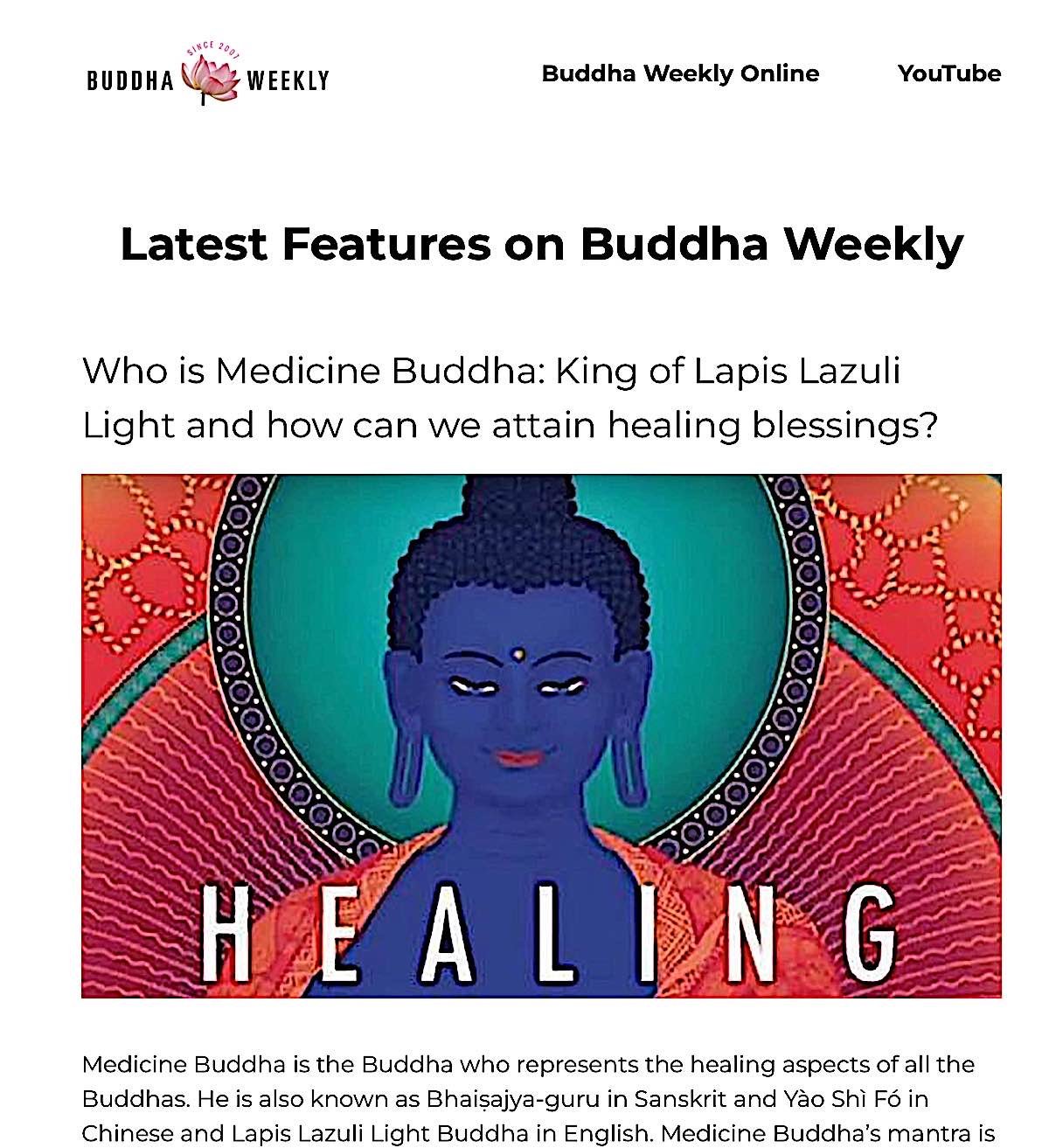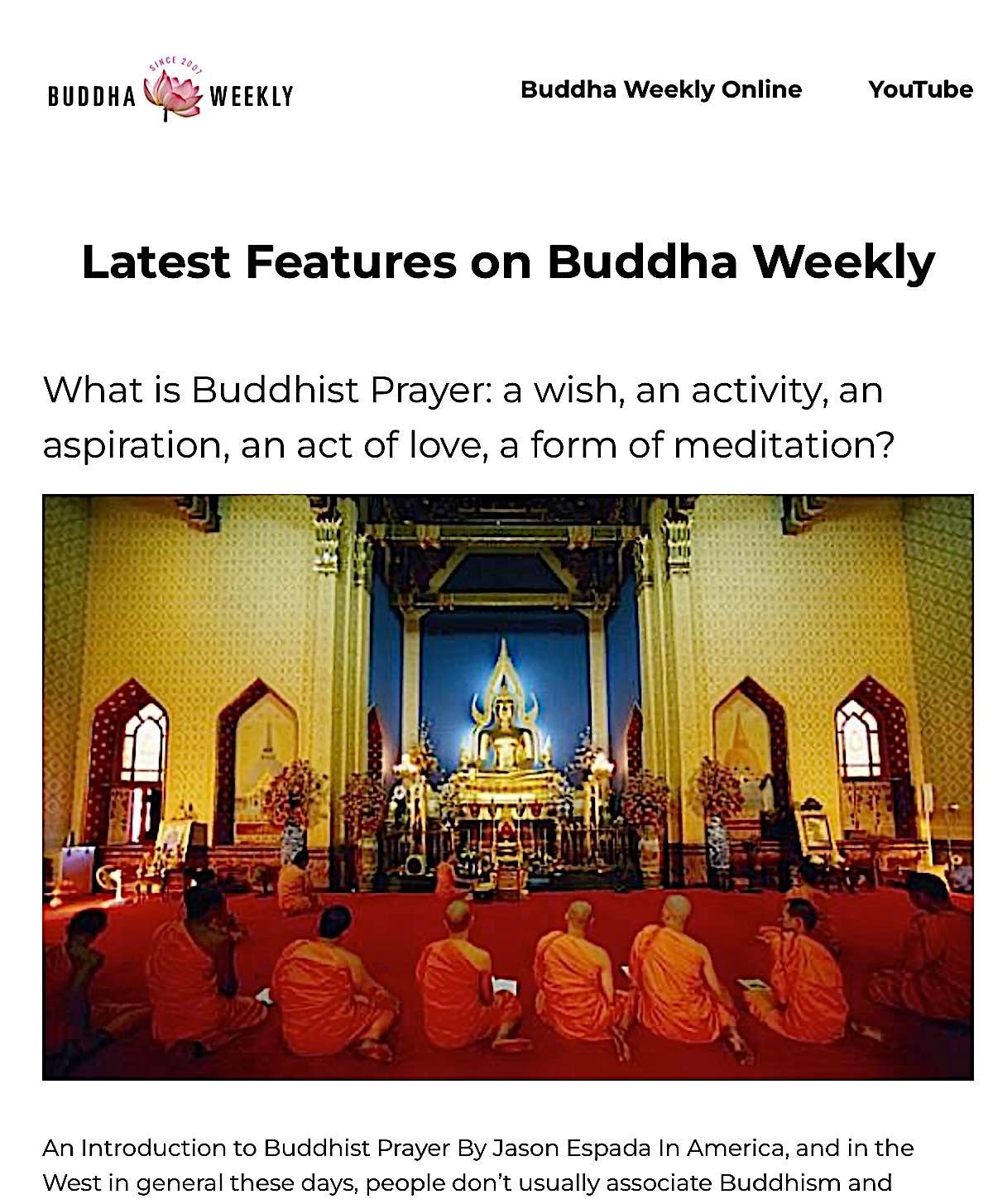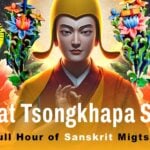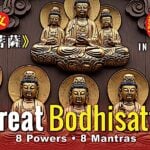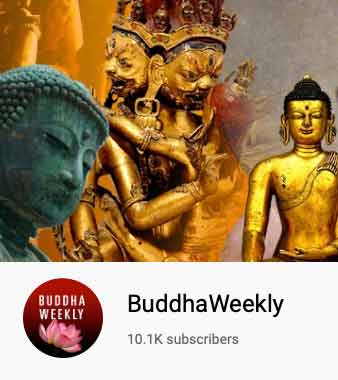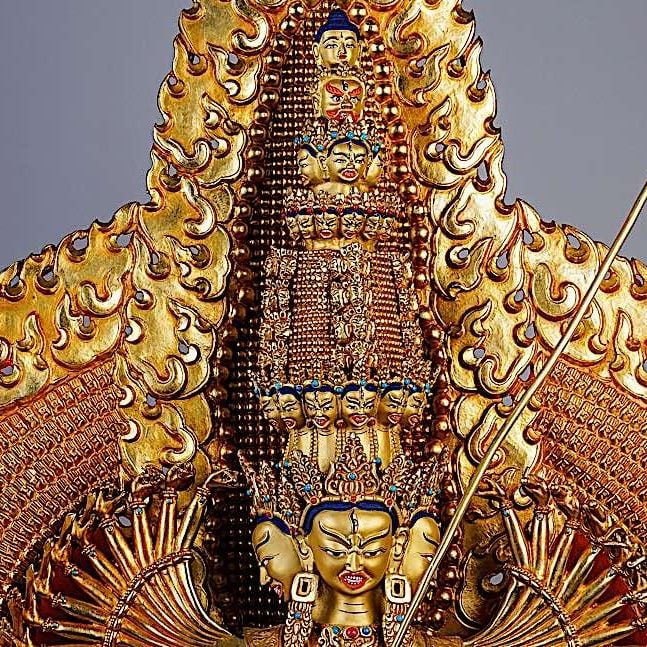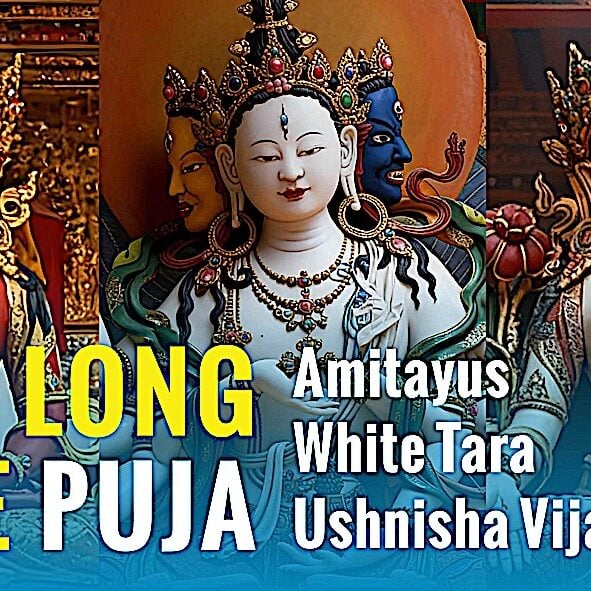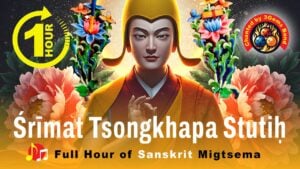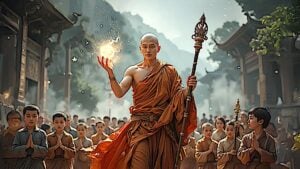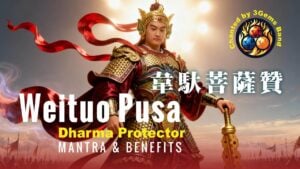Video and Feature: Awaken to the Lion’s Roar — Simahanada Avalokiteshvara: Becoming the Fearless Dharma Hero
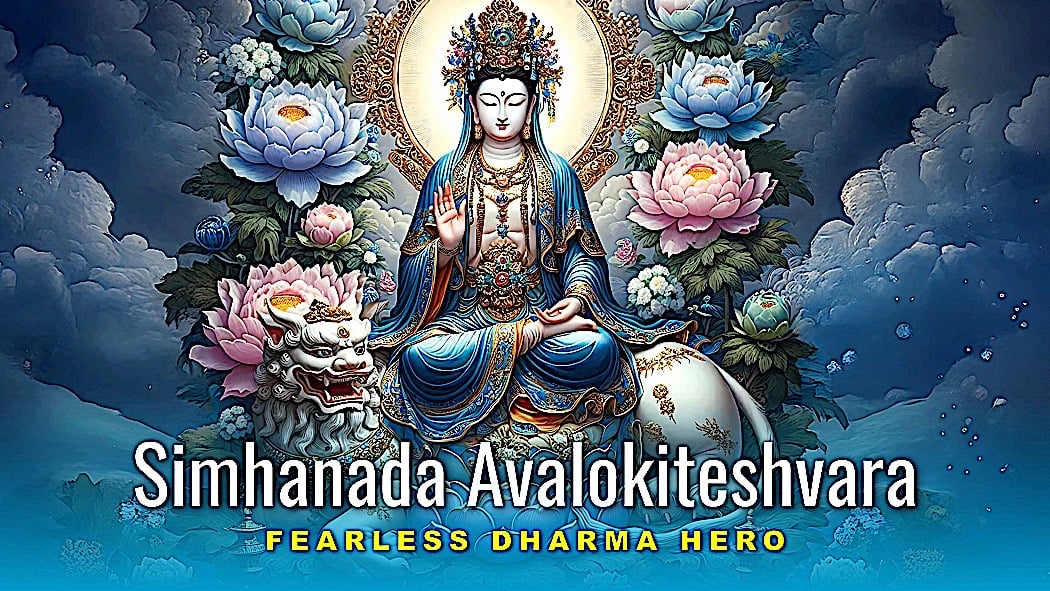
Which of the 108 forms of the great Compassionate Bodhisattva Avalokiteśvara is famous for healing disease, and equally well-known for protection from all harm and danger? Which special Avalokiteśvara practice and mantra ensure that “the four Heavenly Kings” and the other protectors will always accompany you and keep you from harm throughout your life? Why is seeing a snow lion in your dreams, a turning point vision, and what does it actually mean? What does it indicate if we see Avalokiteśvara riding on his back? We answer these questions, and end with the mantras and Dharani of the great Lion’s Roar Lord of the World.
Video:
When you see a snow lion in your dreams, or during your meditation, it’s time to sit up straight and bow your head with respect. In Buddhism the snow lion represents both fearlessness and power. Look the snow lion in the eye if you dare. This is the face that make nagas and dragons cower and prostrate. He has a green mane, blowing in the wind, indicating he is the embodiment of Prana and lungta, or wind. If you are brave enough, to look into his wise eyes, you are on the path of the fearless Buddhist.
Now, if you are supremely fortunate, as you look up from the snow-lion’s awe-inspiring face in your vivid dream or visualization, you’ll see, riding on his back, his lord and companion, the Lord of Compassion Avalokiteśvara. Seeing this glorious Bodhisattva, also known as Lokeshvara, or the Lord of the World, you bow to the fearless hero, on the back of the fearless lion. You bow because you are the most fortunate of beings.
Siṃhanādāvalokiteśvara, is one of the Bodhisattva’s most powerful of his 108 iconic forms, also known as Simhanada Lokeshvara, or Chenrezig Sengge Dra, the Lion’s Roar Chenrezig. This practice is one of the fourteen golden Dharmas of Lupa in the Sakya tradition.
The benefits of his practice are vast and complete. He is the Lord of absolute compassion, but also the lord of total fearlessness. He is the unshakable Dharma warrior who cannot be defeated, even by diseases and hidden danger, demons and worldly dangers. He is the absolute healer and doctor, but equally the defender and hero.
In the Simhanada Tantra, the benefits are proclaimed by Amitabha Buddha, in response to a request by the Blessed One, Shakyamuni Buddha:
” Lord, the gods of the Heaven of the Four Great Kings, the gods of the Heaven of the Thirty-Three, the brahmaputras, and the great brahmas will protect, guard, conceal, and always accompany any being who hears this tantra, thinks of it, worships it, upholds it, or even just takes an interest in it. All the buddhas and bodhisattvas, who are greatly superior to those gods, will protect such beings just as a mother protects her child and the māras will never be able to obstruct them. When they die, they will take birth in lotuses in the western realm of Sukhāvati, freed from the pain of the womb. In this life, they will be freed from any fear of fire or water. Here I have only briefly stated the benefits, but apart from these all that is wished for will be fulfilled exactly as desired.”
It is also Amitabha Buddha who transmits the Dharani and mantra.
Although this aspect of the Lord of the World appears somewhat peaceful, he is visualized as a Dharma hero, the yogi warrior of the Dharma — not ferocious like his more wrathful aspect Hayagriva — but the calm warrior of love and compassion. He has a third eye on his forehead and is pure white to show his purity. His enemies include any enemy of the Dharma or the teachings, and wrong views, any disease-causing spirits and demonic obstacles or other interferences that obscure the mind and body, and all physical dangers in Samsara. For this reason, he is known as the great healer. The Seven great Naga lords all obey him.
As you visualize him, you look up from the great Snow lion to the towering presence of Pure White Avalokiteshvara, and you see he carries a mighty green trident in his right hand, representing the irresistible power of the Three jewels, but it is wound with a white naga to indicate he heals as well as protects, and has complete power over the nagas. He is the soldier doctor on the Dharma battlefield, there to heal your wounds so that you can fight on for the cause for Enlightenment.
Signifying the power of his Enlightened Wisdom, we also see the Wisdom sword usually on a Lotus flower over his left shoulder, with the stem of the lotus held in the left hand which also holds a bowl or skull cup of medicinal flowers. If you visualize the Lord in more detail, he has a lotus throne of five colors, representing the five Buddha Families and five wisdoms and five activities.
His Snow lion is of gigantic proportions signifying his indomitable strength. Even a dragon must cower and fly away when this mighty Snow Lion roars. The lion’s roar is the sound of Dharma speech and its irresistible power of absolute truth. Venerable Jampa Choskyi describes the supreme power of the Snow Lion:
“They roam freely in the high snow mountains without any fear, symbolising the wisdom, fearlessness and divine pride of those dharma practitioners who are actually able to live freely in the high snow mountain of the pure mind, without being contaminated by delusions. They are kings of the doctrine because they have achieved the power to subdue all beings with their great love, compassion and wisdom.”
When he roars, it is the roar of Dharma, Shakyamuni Buddha himself was called, the Lion’s Roar. When the snow lion roars, all beings pay attention, and the nagas and dragons bow down.
His mantra is a mantra of healing, protection and compassion for all beings. Anyone may chant the mantra and visualize the glorious Lord of the World on the Snow Lion in front of them. You take Refuge in the Lord and rely on his protection and compassion and heroic Bodhisattva power. If you have empowerment, you will have permission for a more in-depth visualization.
His root mantra is:
namo ratna trayāya / nama ārya avalokiteśhvarāya / bodhisattvāya / mahāsattvāya / mahākāruṇikāya / tadyathā / oṃ akaṭe / vikaṭe / nikaṭe / kaṭaṃ kaṭe / karoṭe karoṭe / vīrye svāhā
His essence mantra, which many people chant thousands of times per day for blessings, empowerment, protection and healing is:
oṃ āḥ hrīḥ siṃhanāda hūṃ paṭ
As you chant his mantra, see his white healing light, emitting from the Hrih at his heart, going out to all beings in the Universe, saving them. The light also absorbs into your own heart, healing you and surrounding you in white, protective light.
To make this a complete practice, you first take Refuge in the Three Jewels and make visualized or real offerings. It is best to practice the seven limbs, or the King of Prayers to accumulate merit, followed by the mantras as many times as you can, and always finish by dedicating the merit to the cause for Enlightenment, for the benefit of all sentient beings.
We dedicate the merit of this presentation to the benefit of all sentient beings.
More articles by this author
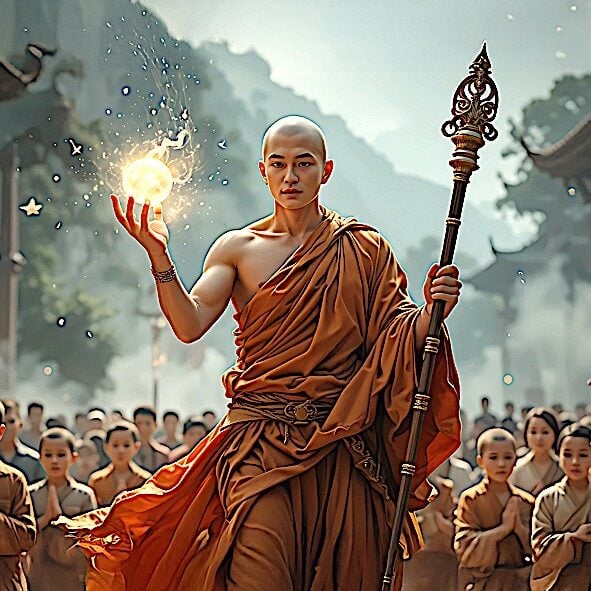
Daśacakra Kiṣitigarbha Dhāraṇī: Rescuing All Beings: The Sanskrit Dharani that Saves Beings on Hearing or Seeing or Chanting
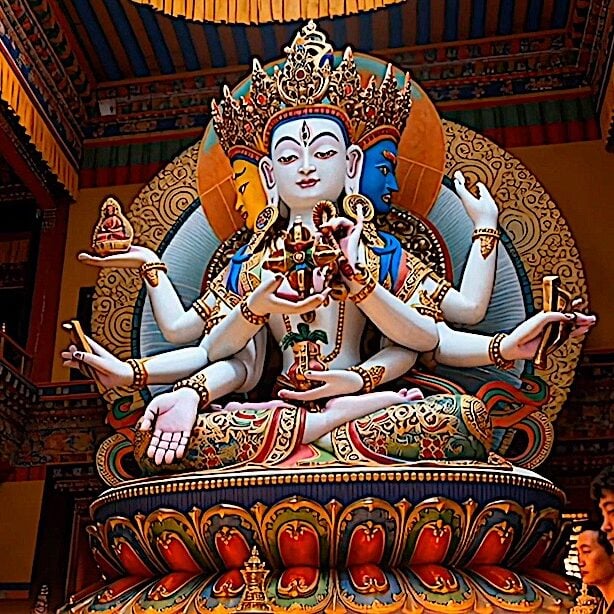
ON HEARING: Ushnisha Vijaya Dharani Overcomes Six Types of Suffering, Conquering the Lord of Death: Supreme in Six Realms
Search
Latest Features
Please support the "Spread the Dharma" mission as one of our heroic Dharma Supporting Members, or with a one-time donation.
Please Help Support the “Spread the Dharma” Mission!
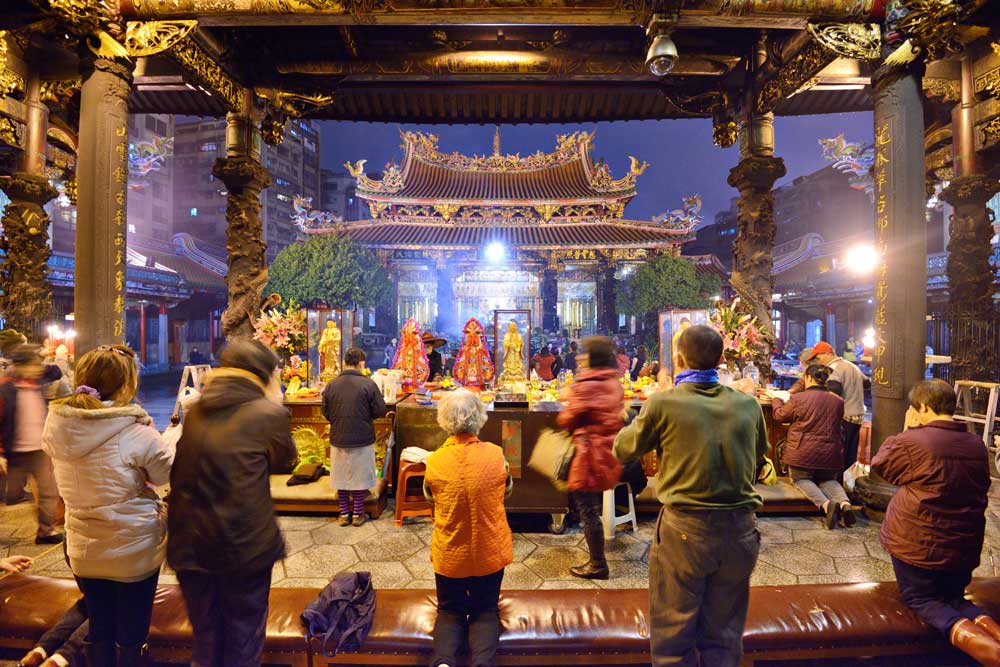
Be a part of the noble mission as a supporting member or a patron, or a volunteer contributor of content.
The power of Dharma to help sentient beings, in part, lies in ensuring access to Buddha’s precious Dharma — the mission of Buddha Weekly. We can’t do it without you!
A non-profit association since 2007, Buddha Weekly published many feature articles, videos, and, podcasts. Please consider supporting the mission to preserve and “Spread the Dharma." Your support as either a patron or a supporting member helps defray the high costs of producing quality Dharma content. Thank you! Learn more here, or become one of our super karma heroes on Patreon.
Lee Kane
Author | Buddha Weekly
Lee Kane is the editor of Buddha Weekly, since 2007. His main focuses as a writer are mindfulness techniques, meditation, Dharma and Sutra commentaries, Buddhist practices, international perspectives and traditions, Vajrayana, Mahayana, Zen. He also covers various events.
Lee also contributes as a writer to various other online magazines and blogs.
